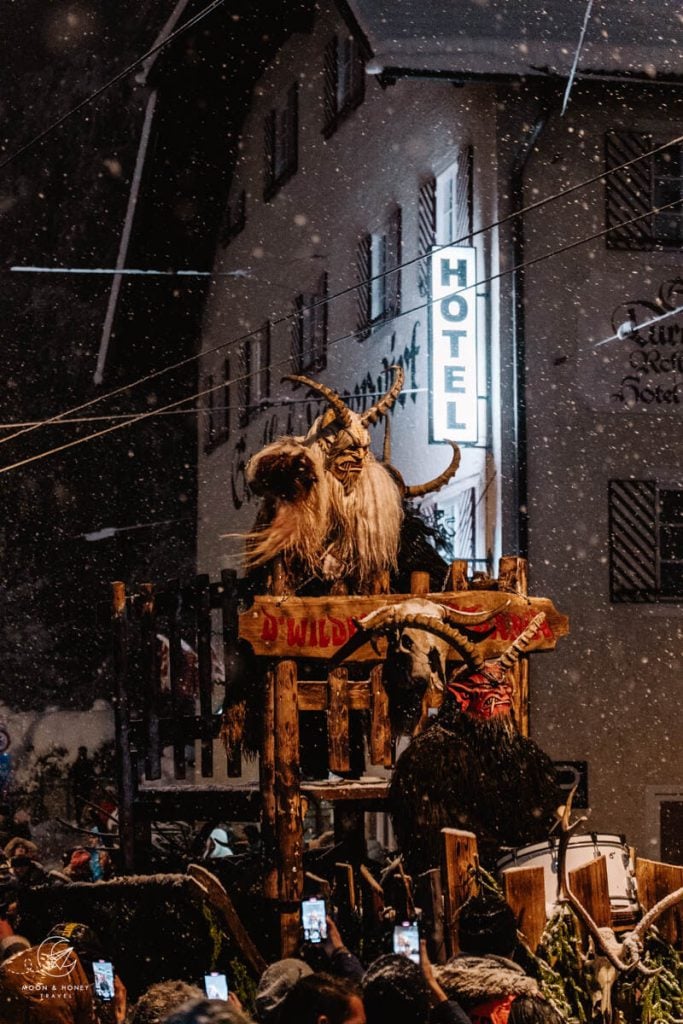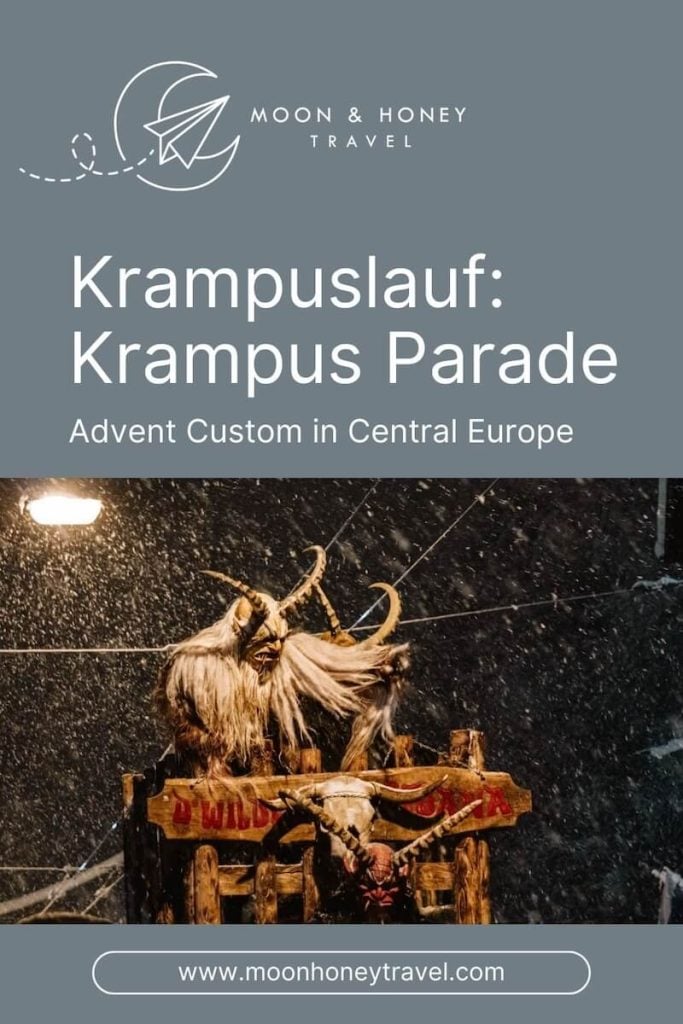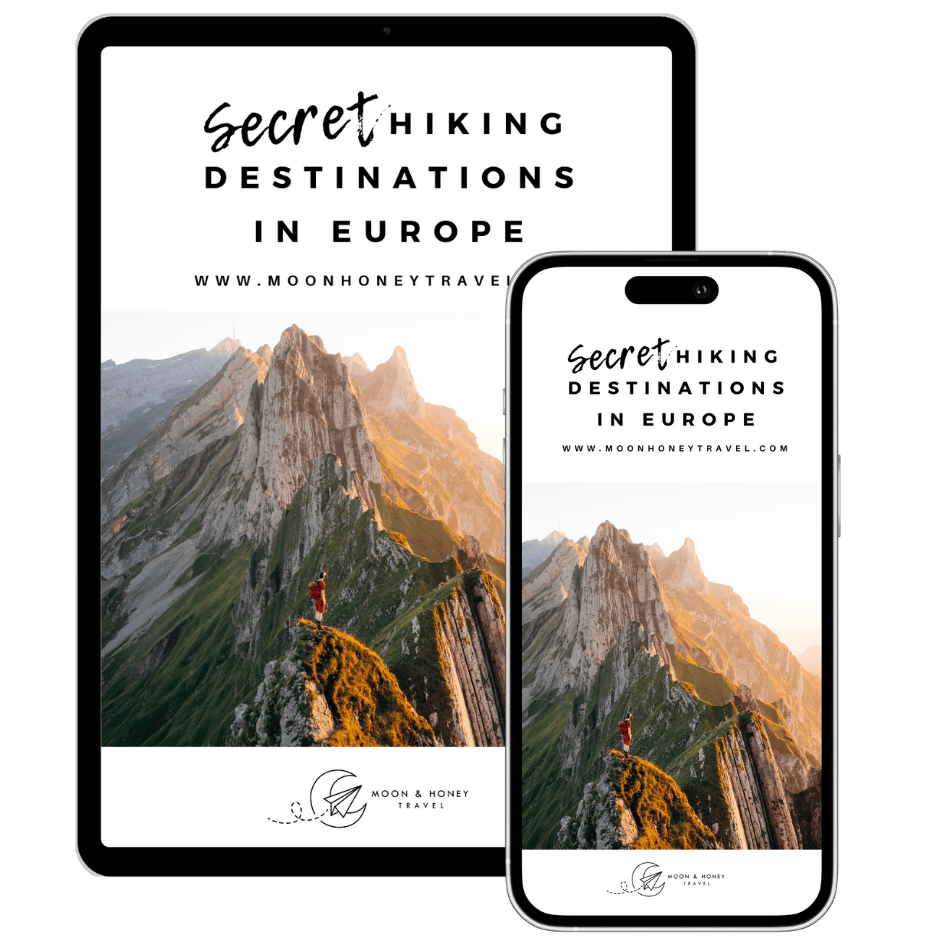A Krampus is a frightening half-goat, half-demon figure in the Advent customs across the Eastern Alps of Europe.
A Krampuslauf (“Krampus Run”) is a performative procession of costumed Krampus, led by Saint Nicholas.
Clad in nightmarish masks and furry costumes, Krampus characters create a nightmarish spectacle with erratic movements, melodramatic gestures, and loud clanging bells.
These Krampus runs take place across the alpine regions of Central Europe during the Christmas season. The Krampuslauf tradition is mostly associated with Austria and Germany, but Krampus Runs also take place in Northeastern Italy and Slovenia.
Krampus runs are organized by local Krampus clubs. A Krampuslauf can involve one club, or many regional clubs.
In a well-established Krampus parade, it’s likely that you’ll see 20+ Krampus clubs parading through the street, or square. Such an event can last up to 2 hours.
Read on to learn more about this wild and unusual alpine tradition.

- Where to See Krampus Runs: Austria, Bavaria (Germany), and South Tyrol (Italy)
- When to See Krampus Runs: November and December
- Krampusnacht (Krampus Night): December 5th
What is a Krampus

A Krampus is a horned, devil-like figure in Central European folklore. Common features of a Krampus are goat-like legs, a shaggy body, long hair, clawed hands, long curved horns, and fanged teeth. Krampus carry chains, bundles of twigs, and sometimes large baskets.
In Austria, the Krampus serves as the foil character to St. Nicholas. During the Advent season, a Krampus scares and punishes naughty children, whereas St. Nicholas rewards well-behaved children with gifts.
Though embedded in the Catholic traditions of alpine Germanic Europe, it’s likely that the Krampus was a pagan figure in winter solstice rituals.
In German folklore, the Krampus is essentially Knecht Ruprecht, the companion of Saint Nicholas.
In the Baroque Era (1800s), it was common for a dressed-up St. Nicholas to visit houses with a chained Knecht Ruprecht, or Krampus in tow. The purpose of this display was to show that good triumphs over evil.
Krampus also served as an educational tool, albeit a problematic one. Fear of being kidnapped by Krampus was an effective way to make children behave.
The Krampus tradition continues to change. While house visits still happen, Krampus mostly parade through villages and towns in official Krampus Runs (“Krampuslauf” in German).
What is a Krampuslauf

A Krampuslauf is a theatrical parade, where St. Nicholas leads a procession of costumed Krampus through a village, town, or designated area (e.g. Christmas Market, Square, etc…).
The Krampus participants don alpine bells, frightening masks, and shaggy, animalistic costumes. You’ll hear them before you see them.
Side note: Krampus masks are traditionally made of Swiss Pine wood. It takes 20-25 hours to carve a mask. On average, these Krampus masks cost 800 EUR.
The Krampus run, jump, and strut back-and-forth, side-to-side, with great flair and pizzazz. It’s an absolute riot to hear and see.
Their intention is to scare, taunt, and “punish” spectators.
Punishment entails hitting feet and legs with bundles of twigs, ruffling up hair, stealing beanies (and later returning them), shaking shoulders, etc…
The night of December 5th is celebrated as Krampusnacht (Krampus Night). However, Krampus runs take place between late November and early November.
During this time, hundreds of Krampus runs take place across the Eastern Alps.
Most Krampus Runs are organized events with on-site security, paramedics, and even firefighters and police.
How to Attend a Krampuslauf

We recommend researching where and when these events take place. It’s unlikely that you’ll just stumble upon one. Tourist offices publish upcoming Krampus parades on their websites.
We suggest arriving at the Krampuslauf location 30-40 minutes before the Krampus parade begins.
Krampus Runs are free events.
Know that your participation signals consent to play along. Some Krampus runs have a “Krampus Free Zone,” but those are rare.
Minimize your alcohol consumption.
And, have a great time!
Our Experience: Attending the Gnigler Krampuslauf in Salzburg

Kati and I attended the Gnigler Krampuslauf in Salzburg in December, which was a parade of nearly 40 different Krampus clubs (850 total Krampus) hailing from all over Salzburgerland, Upper Austria, and Bavaria.
During the 2-hour spectacle, each club swaggered down the street, scarring and “punishing” spectators along the way.
In this particular Salzburg Krampus Run, there was a barrier that divided the performers from the spectators. The Krampus were not allowed to cross the barrier.
Those that didn’t want to interact directly with Krampus could simply stand at a distance.
This event was child-friendly and safe. There were paramedics, fire fighters, police, and security on site.
We absolutely loved it.
Krampus Festival Safety

Krampus Runs vary in terms of size, safety parameters, club participants, and overall leadership intent.
Krampus Runs are generally safe.
But, the atmosphere can contribute to aggressive behavior. On some occasions, drunk spectators have retaliated. On other occasions, Krampus characters have “lost control” and have hit onlookers excessively.
If you’re concerned about your safety, we recommend seeking out a child-friendly Krampus Run, or a Krampus Run without alcohol.
We also recommend attending a Krampuslauf that has a barrier that separates the Krampus troupes from the public.
Also, research the Krampus Club that’s hosting the event. Though most Krampus Clubs adhere to strict rules of conduct, some Krampus Clubs are stricter than others.
Krampus versus Perchten

If you’re visiting Austria around the Winter Solstice, you may also come across a Perchtenlauf, or a Perchten Run.
Perchten are often mistaken for Krampus, but their role is different.
Perchten are pre-Christian, mythical creatures that serve to drive the winter demons away.
In a time when winter storms and cold weather were life-threatening, the Perchten rituals symbolized man’s control over uncontrollable events (e.g. avalanches, famine, raids, etc…).
While the origin of the Percht is unclear, it’s possible that it’s related to the goddess Perchta (Frau Percht).
Fire plays a central role in Perchten rituals. In Perchten runs, costumed Perchten often wield torches.
Today, Krampus and bad Schiechperchten are often mixed up. It’s not uncommon to see Perchtengänger in Krampus Runs. So, it’s all very confusing.
Krampus’ Growing Popularity

Rarely depicted in chains these days, Krampus no longer serves as a symbol of good defeating evil. I wonder, what does Krampus represent in today’s culture?
The tradition is gaining popularity each year, beyond the borders of the Alpine region of Europe. Why is the Krampus figure so appealing? What does it symbolize?
I believe that there are many different reasons for the expansion of the tradition.
In Austria and Germany, the Krampus is an opportunity to reconnect with local traditions and customs.
In the USA, the Krampus may be a “reaction to the commercialization of Christmas.”
What are your thoughts?
Winter Travel in Europe
Austria:
Germany:
Italy:
Belgium:
Winter Sun Destinations:
- Tenerife Road Trip, Canary Islands
- Tenerife in January
- Gran Canaria Road Trip, Canary Islands
- Malta in February
Alps Trip Planning Essentials
When to Visit the Alps
We recommend visiting the Alps in summer (June – mid September), fall (mid September – late October) or winter (late December – March).
Read Alps in Summer to learn everything you need to know about visiting the Alps between June and mid/late September.
What to See & Do in the Alps
- See a traditional Almabtrieb cattle drive in September.
- Experience a Krampuslauf in November, or December.
- Hike hut-to-hut across the Alps in July, August, or September.
- Walk through a narrow gorge like Partnachklamm in Bavaria, or Wolfsklamm in Austria.
- Stay in a spa hotel like My Arbor in South Tyrol, Italy.
- Bathe in a thermal spa like Aqua Dome in Austria.
Alps Road Trips
Most destinations in the Alps are accessible by transit. If you’re visiting during peak seasons, we recommend traveling with trains and buses.
If you’re visiting during shoulder seasons (late May, early June, late September, October), a car is often essential in getting around.
When we go on hut-to-hut hikes, we always travel with transit. When we want to do a lot of day hikes, we find it easier to travel with a car.
We recommend using the Discovercars.com car rental reservation platform to search for and book car rentals. This easy-to-use booking platform compares car rental deals from 500+ trusted providers, so that you can choose the best option for your trip.
Alps Road Trip Itineraries
- Italian Alps: 5 Day Dolomites Road Trip
- Italian Alps: 7 Day Dolomites Road Trip
- Italian Alps: 10-14 Day Dolomites Road Trip
- Bavarian Alps and Tyrolean Alps: 10-Day Bavaria and Tyrol Road Trip
- Austrian Alps: 2-Week Austria Road Trip
- Austrian Alps: 1 Week Austria Road Trip
- Slovenian Alps: 2-Week Slovenia Road Trip
- Slovenian Alps: 5-Day Slovenia Road Trip
Alps Hiking Guides
Hiking in the Alps is our passion.
To learn about when to hike, where to hike, and hiking safety, read: Hiking in the Alps: Essential Tips. For trail inspiration, check out Best Hikes in the Alps.
For region specific trail inspiration, read:
- Bavarian Alps: Best Hikes in Garmisch-Partenkirchen
- Italian Alps: Best Day Hikes in the Dolomites
- Austrian Alps: Best Day Hikes in Austria
- Slovenian Alps: Best Hikes in Slovenia

Pin this Image for Future Trip Planning!
Stay Connected:
Connect with us on Pinterest.
Follow us on Instagram.
Like us on Facebook.
Support Us:
If you love reading our content, you can buy us a coffee via Ko-Fi.



